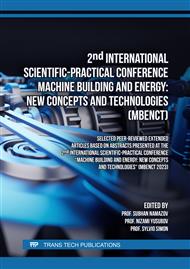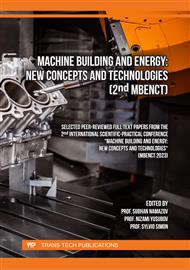[1]
V.A. Efimushkin, I.V. Uglov. QoS architecture for converged networks and features of its application. T-Comm - Telecommunications and Transport. 7, (2020), 162-163.
Google Scholar
[2]
I.V. Uglov. Prospects for creating virtual convergent networks. T-Comm – Telecommunications and Transport. 7, (2012), 215-218.
Google Scholar
[3]
A.V. Roslyakov, M.Yu. Samsonov. Models and methods for assessing the quality of IP telephony services. Telecommunications. 1, (2012), 15-18.
Google Scholar
[4]
Ali-Yahiya T. Understanding LTE and its Performance. –Orsay, France:Springer, (2011).
Google Scholar
[5]
V.A. Tikhvinsky, S.V. Terentyev, V.A. Koval, E.E. Devyatkin. Development mobile communication networks from 5G Advanced to 6G: projects, technologies, architecture. M.: Technosphere, (2023).
Google Scholar
[6]
Amanullazade F.I., Ibrahimov B.G., Gumbatov R.T., Namazov M.B., Ibrahimov R.F. Research and analysis of the effectiveness multi-service telecommunication networks based on SDN and NFV technology. Collection scientific articles - XII-International scientific, technical and scientific-methodological conference -Current problems of information telecommunications in science and education. St. Petersburg : SPbSUT. 4, (2023), 544 – 548.
Google Scholar
[7]
O.I. Shelukhin. Modeling of information systems. Textbook for universities.M.: Hotline – Telecom. (2018).
Google Scholar
[8]
Tatarnikova T. M. Statistical methods for studying network traffic. Information and Control Systems. 5, (2018), 35 – 43.
Google Scholar
[9]
B.G. Ibrahimov, Y.S. Isayev, M.E. Aydemir. Performance of MultiService Telecommunication Systems Using the Architectural Concept of Future Networks. Journal of Aeronautics and Space Technologies. Vol. 16, No.1, 2023. pp.41-49
Google Scholar
[10]
B.G. Ibrаhimov, E.Q. Hashimov, A.H. Hasanov, T.H. Mammadov. Research throughput multiservice telecommunication networks. Desyata mizhnarodna naukovo-tekhnichna konferentsiya -Suchasni napryamy rozvytku informatsiyno-komunikatsiynykh tekhnolohiy ta zasobiv upravlinnya, Kharkiv, April 9, 10. V1. 2020. pp.30-32.
Google Scholar
[11]
A.Rustamov, M.Binnetov, K.Gurbanov. Ensuring reliability in upgrading and maintaining special-purpose radioelectronic equipment. Vasil levski national military university security and defense scientific journal year, II Issue 2, 2023. pp.1-7.
Google Scholar
[12]
P. Kihong, Willinger W. Self-Similar network traffic and performance evaluation. New York, John Wiley & Sons, Inc., (2000).
Google Scholar



